Fostering the Brilliance of World Language Students Through Explore-Before-Explain

Fostering the Brilliance of World Language Students Through Explore-Before-Explain
Recently, Pat Brown and I had a featured article in the Spring 2024 issue of ACTFL’s of ‘The Language Educator’. I know that some do not have access to the article, so I wanted to share a summary of the article and our contribution to language learning and acquisition.
The “Explore-Before-Explain” Instructional Sequence
The “Explore-Before-Explain” instructional sequence encourages rethinking teaching roles, increasing student agency, and aligning instruction with the World-Readiness Standards for Language Learning. This approach supports a facilitative teaching style that not only emphasizing comprehension and practical language use over memorization, but also prepares students for effective communication and interaction in a global context.
“Explore-Before-Explain” starts by engaging students’ curiosity and ideas based on their life experiences. It utilizes these preconceptions to spark curiosity and critical thinking, integrating students’ first language with new language learning.
It progresses to activities promoting critical thinking and the integration of their first language (L1) with the new language. (These activities facilitate a deeper understanding.) Teachers also enhance learning by explaining critical grammatical differences (at the appropriate time) and addressing student questions to deepen comprehension.
The process ends with reflective practices, allowing students to evaluate their understanding and teachers to assess proficiency and readiness.
Four Essential Planning Considerations
Below you will find the four essential planning considerations in the “Explore-Before-Explain” instructional sequence aimed at fostering deeper understanding and engagement in world language students.
Planning Consideration 1: Targeting Lived Experiences – Students are active meaning-makers, and instruction should connect their past experiences with new language learning. Layered activities – like reading, listening and speaking – that relate to students’ experience help bridge their first language (L1) with new language learning and acquisition.
Planning Consideration 2: Using Critical and Logical Thinking as Tools for Sense-Making – Students should use critical thinking strategies such as pattern recognition and cause-and-effect relationships to make sense of new language learning. This transforms passive learning into active meaning-making. This approach enhances sensemaking and helps students construct robust language understanding.
Planning Consideration 3: Planning Enhancing Understanding – Teachers should plan activities that help students demonstrate their understanding and apply it to new contexts. Focusing on fewer, conceptually significant ideas, rather than superficial coverage, allows for deeper engagement through readings, discussions, and targeted vocabulary instruction.
Planning Consideration 4: Reflection on Developing Understanding – Reflection allows students to assess their learning progress and set future goals. Activities – like exit tickets – help students think about what they’ve learned and plan for continued growth. This fosters metacognition, leading to better problem-solving and independent learning.
In Conclusion
“Explore-Before-Explain” teaching helps world language educators prepare students for the 21st century by emphasizing critical learning aspects for a more compelling and memorable experience. By focusing on the big ideas in the four Planning Considerations, educators can develop more robust effective lessons for their students. This instructional design process helps educators build the capacity to create classroom experiences that are culturally relevant and accessible to every learner. This approach also effectively addresses the need for preparing students for a fast-paced, technology-driven world, promoting global readiness and enhancing the overall instructional design process.